Stories
Designer Leather
1980s
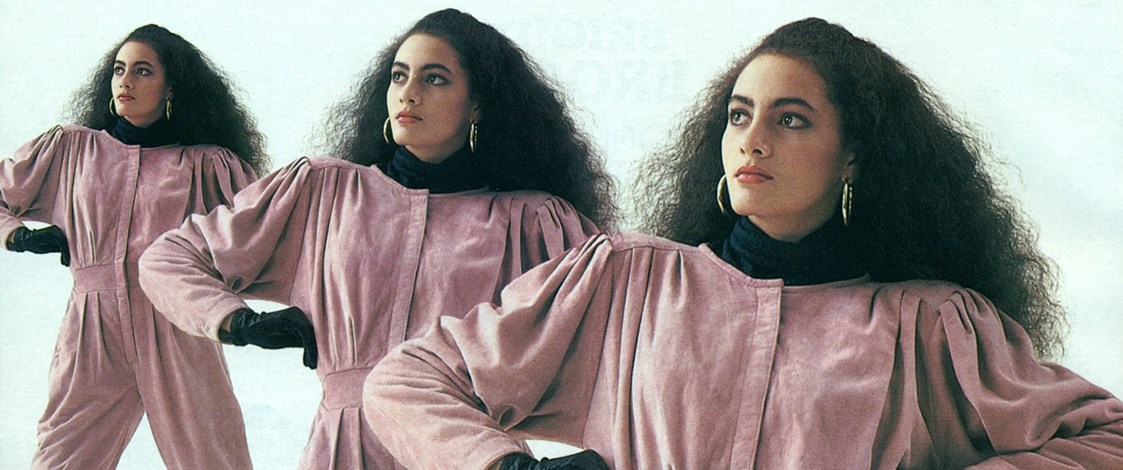
In 1982, Time, a magazine not noted for its fashion reportage, devoted a full-colour, four-page spread to leather fashion as seen on the international catwalks. In New Zealand too, the use of leather as an upmarket fashion medium was gaining momentum.
The 1980s brought forth a new wave of talented designers dedicated to working with leather while existing manufacturers of leather clothing such as Knight Tailors in Invercargill and Bristed Brothers (Skin Things) in Wellington became more adventurous in their approach.
There was nothing demure about leather. Sleek, polished and expensive, it had attitude in spades. Cut from skin, the archetypal 80s power-suit, with its broad-shouldered, whittle-waisted jacket and short, tight skirt, epitomised the hard-edged chic of the decade.

Lambsuede jacket with calfskin trim and calfskin skirt. Caroline Moore for Frenzi. Fashion Quarterly, Winter 1989.
Of the 17 New Zealand tanneries operating at the time, only a few specialised in the production of leather suitable for high fashion clothing. Taking advantage of new techniques and technology, they developed leathers (sheep, calf, deer, pig and goat) that were finished, textured and printed in various ways, providing designers with plenty of scope for artistry and innovation.
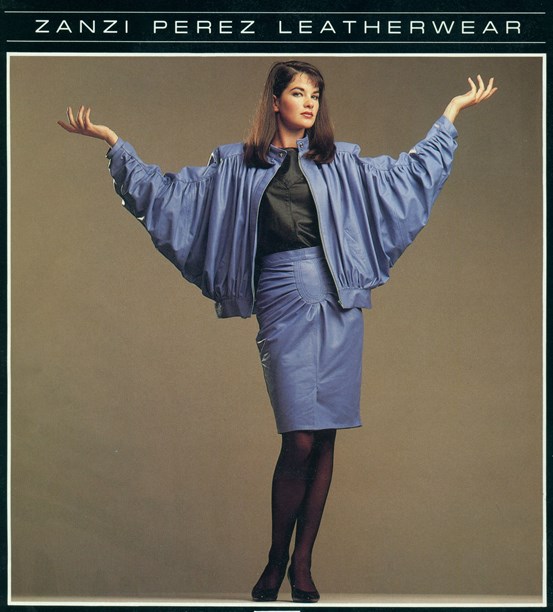
1988 advertisement for a Magyar-sleeved jacket, draped skirt and fitted top made by Zanzi Perez with leather supplied by a leading New Zealand tanner, E.Astley & Sons. Image © Zanzi Perez.
Prints were stamped on leather by means of a 50 tonne press and a rock-washed effect was produced by literally washing the skin with rocks. Teresa Gratkowski-Amaru of Wellington won the Leather Industry Award in the Benson & Hedges Fashion Design Awards in 1986 for a rock-wash leather miniskirt, top and jacket with possum fur trim. Rock-wash leather was also a favourite of Kevin Bradshaw and Debra Thompson who started the Skinfits label in 1984 and opened their own shop in Auckland’s Parnell Village a short time later.
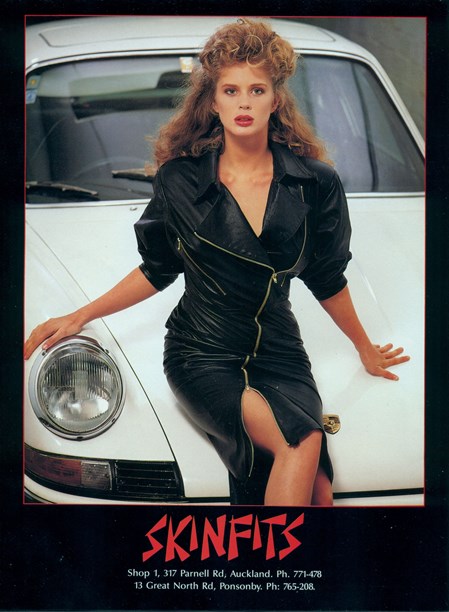
A 1988 advertisement for Skinfits black leather dress with a neck-to-hem zipper.
When it came to colour, black, purple, rich russets and aubergine vied for attention with vibrant blues, yellows and reds. Colours were often used in combination, red and black being a popular choice.
Warden Neil’s predilection for brilliant colour and exaggerated styling defined him as the most flamboyant of the leather designers. After working as a costume designer in Hollywood for 21 years, he returned to Auckland in 1986 where, under the auspices of the Alta Moda Corporation, he presented his debut leather collection at the Regent Hotel. Although he no longer dressed the stars, he clearly intended that every woman who wore his clothes should feel like one. He named each of his designs after an iconic movie actress.
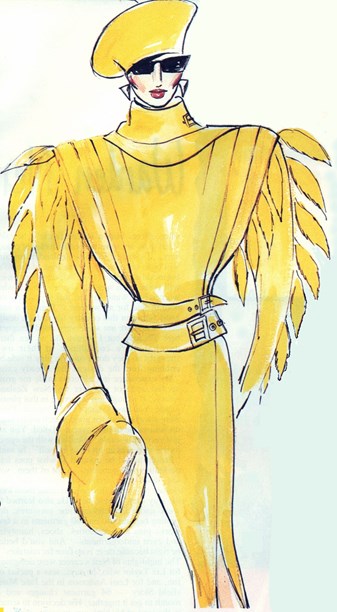
Yellow leather suit designed by Warden Neil for his debut collection in 1986. Dyed fur tails dramatise the sleeve and shoulder line and the jacket pleats into a tight peplum.
Caroline Moore, the designer behind the Frenzi label became known for her meticulously tailored separates and dresses which she produced with the help of a relatively large staff in her Christchurch workroom. Caroline worked exclusively in New Zealand leather, the material dictating the style of her clothing as much as the demands of fashion. She sourced her lambskin from NZ Light Leathers in Timaru, then the largest tanner of finished garment leather in the country.
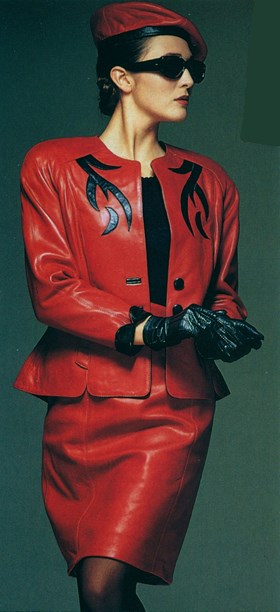
Red leather suit with black leather detailing. Caroline Moore for Frenzi, winter 1990.
Lambskin was processed into either nappa, the outside of the skin, or suede, the flesh side abraded to raise a nap. In the 1980s, the number of lamb pelts available to the tanning industry each year was in the vicinity of 30 million.
Napier designer Trish Beach also used NZ Light Leathers’ lambskin. Taking advantage of the skin’s softness, lightness and silky feel, she created distinctive day and evening wear with the drape and hang of a fine fabric. Trish received three nominations in the 1986 Benson & Hedges Fashion Design Awards and the following year won both the Leather Industry and Supreme Awards. At a time when other designers were pushing the boundaries, Trish’s designs had a femininity and refinement that recalled a more elegant age.
Brigid Brock began designing leatherwear under her own name in Christchurch in 1982. Her approach, typified by fitted skirts, broad-shouldered jackets, matador pants, boleros and backless vests, was very modernistic and European. When designing a collection, she conceived the shape of a garment first then made the raw material conform. Brigid supplemented her use of New Zealand leather with specialised skins imported from Europe. Screen-printed leathers were part of her signature look.
The lust for leather also created a demand for designer accessories such as belts. Before Libby Lockhart started her belt business, Libby Leather, in 1986, she had already made skin garments to order for a varied clientele, designed coloured motorcycle leathers for the speedway riders at Western Springs and devised bullet-proof vests for TV stuntmen. The turquoise nappa swimsuit worn by actress Donagh Rees in the 1983 New Zealand movie Constance was another of her designs. Libby’s belts, which included hip sashes, loop-ties and padded, sculptured designs, often screen-printed or hand-painted, were crafted from local leathers or exotic skins. In addition to her commercial ranges, Libby made belts to order. Clients would bring her a special buckle, for example, sometimes a family heirloom, and she created a belt around it.
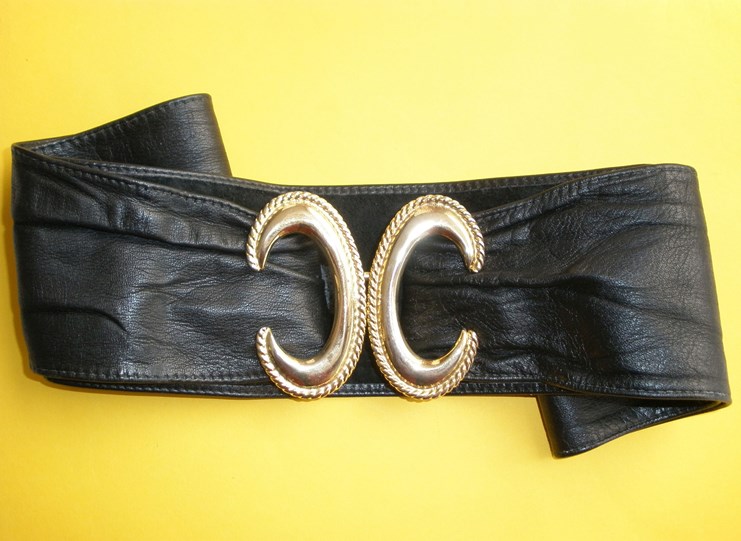
Nappa belt custom-made in 1987 by Libby Leather for a client whose name began with the letter C.
Nita Henry, who was based in Christchurch, made her name as a designer of offbeat leather fashion for the younger market. There was always an element of fantasy in her designs. She devised party dresses with black leather corset tops and tulle skirts, short white shift dresses featuring screen-printed comic-strip motifs, collage-style jumpers in leather and wool and skating dresses trimmed with fur and decorated with snowflakes and stars. For her 1986 winter collection, Nita referenced milkmaids, dandies and braided naval cadets. She had her own shops, Zulu, in Auckland, Wellington and Christchurch and was a long-time entrant in the Benson & Hedges Fashion Design Awards, receiving 20 nominations overall.
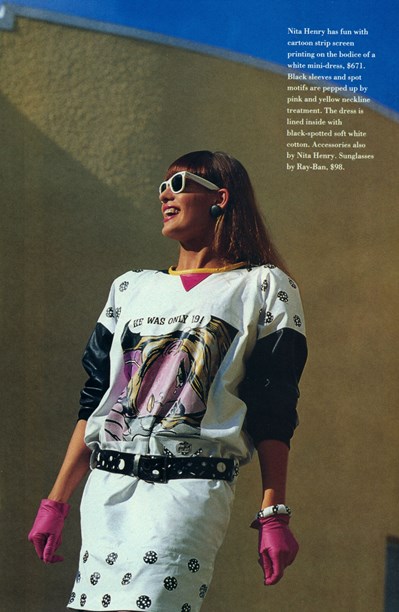
Nita Henry white leather mini-dress screen-printed with a comic-strip motif. The hip belt and lollipop pink gloves are also by Nita Henry. Image © More magazine, February 1987.
The introduction of the Leather Industry Award, sponsored by the NZ Tanners Association, in the 1986 Benson & Hedges Fashion Design Awards, did much to raise leather’s profile as a fashion leader. Initially, the award had no special section of its own but the response by contestants was so overwhelming - 22 of the 80 nominations were leather - that in 1987 a leather category was added. Commenting on the 1986 nominations, Fashion Quarterly noted: "This was leather as we’d rarely seen it before - pleated, jewelled and appliqued, styled into suits, chemises, pants, evening gowns and even a riding habit with black suede jodhpurs and a scarlet hunting coat."
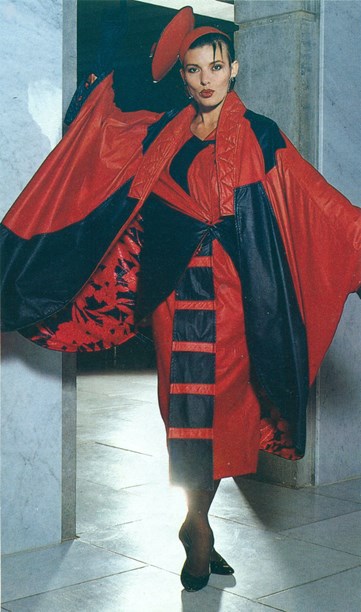
Diana Lee Shun Wong of Wanganui won the Young Designer Award in the 1986 Benson & Hedges Fashion Design Awards with this orientally-inspired leather ensemble. Photo by Sal Criscillo.
As 1980s’ ostentation gave way to grunge dressing and a 1970s’ revival, interest in leather fashion waned. Although leather clothing continues to be produced in New Zealand, it is on a much smaller scale and the styling is more conservative.
Text by Cecilie Geary. Banner image © Skin Things.
Last published September 2017.